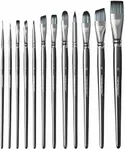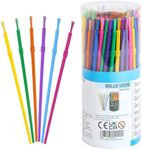Buying Guide for the Best Artists Paint Brushes
Choosing the right artist's paint brush can significantly impact the quality of your artwork. The right brush will help you achieve the desired effects and make your painting experience more enjoyable. When selecting a paint brush, consider the type of bristles, the shape of the brush, the size, and the handle length. Each of these factors plays a crucial role in how the brush performs and how comfortable it is to use. Understanding these key specifications will help you make an informed decision and find the best fit for your artistic needs.Bristle TypeThe bristle type is important because it affects the brush's performance and the texture it creates. Bristles can be natural, synthetic, or a blend of both. Natural bristles, such as hog or sable, are great for oil paints and provide a smooth application. Synthetic bristles are versatile and can be used with various types of paint, including acrylics and watercolors. They are also more durable and easier to clean. If you are a beginner, synthetic brushes are a good starting point due to their versatility and ease of maintenance.
Brush ShapeBrush shape determines the kind of strokes you can make and the effects you can achieve. Common shapes include round, flat, filbert, and fan. Round brushes are versatile and can be used for detailed work and broad strokes. Flat brushes are ideal for bold, sweeping strokes and filling large areas. Filbert brushes have a rounded edge, making them great for blending and creating soft edges. Fan brushes are used for blending and creating textures like grass or fur. Choose a shape based on the techniques you plan to use in your artwork.
Brush SizeBrush size is indicated by a number and affects the width of the stroke. Smaller numbers (e.g., 0, 1, 2) are used for fine details and intricate work, while larger numbers (e.g., 10, 12, 14) are suitable for covering larger areas and making bold strokes. Consider the scale of your artwork and the level of detail you need when selecting a brush size. Having a range of sizes in your collection will give you more flexibility in your painting.
Handle LengthHandle length can affect your comfort and control while painting. Short handles are typically used for detailed work and are ideal for painting on small canvases or when working close to the surface. Long handles are better for larger canvases and allow for more expressive, sweeping strokes. Choose a handle length that feels comfortable in your hand and suits your painting style.

















